Explained: Dog With Two Different Colored Eyes [With Photos!]
Many dog owners have a vision of the dog they want in their family and how that dog may look. For example, many prospective dog owners will think about the breed, the look, and the size of the dog they want. However, many dog enthusiasts may not be familiar with some unique traits that can happen in any dog.
Heterochromia is a condition that creates a dog with two different colored eyes and is likely a result of a genetic mutation. This presentation has no correlation with other disorders or ailments in most cases.
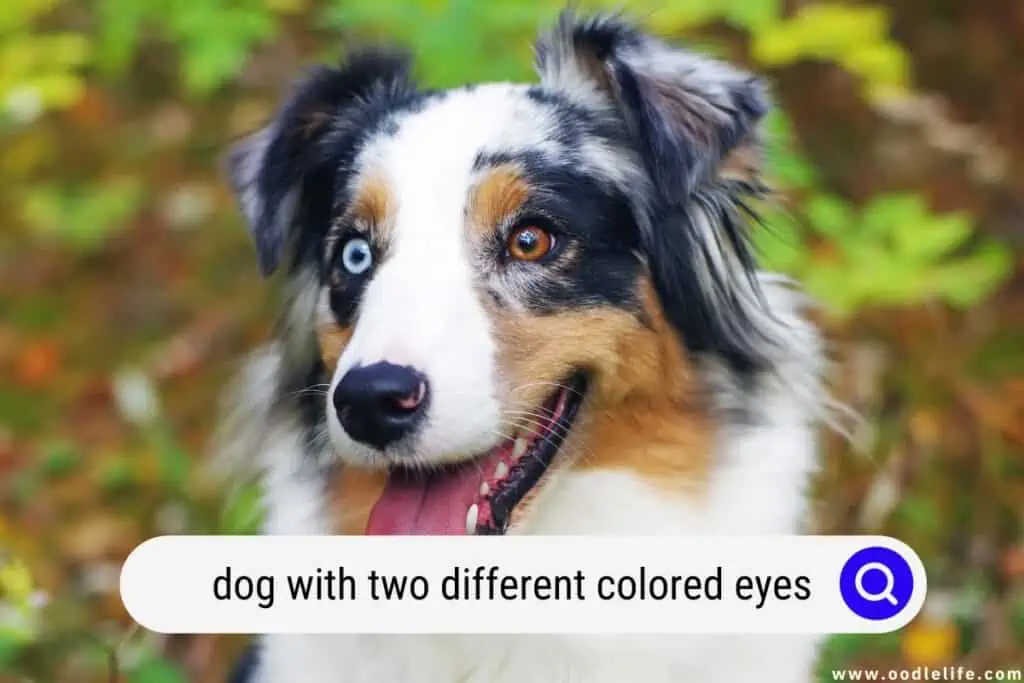
Read on to learn more about dog heterochromia, how it can present, and what it can mean for your precious pup.
What Is Heterochromia?
Heterochromia is when a dog has two different colored eyes, but this condition can present in multiple ways. Heterochromia is when an eye lacks melanin in an entire or part of the eye. This condition will likely cause one eye to appear ice blue or white while the other might be brown or green.
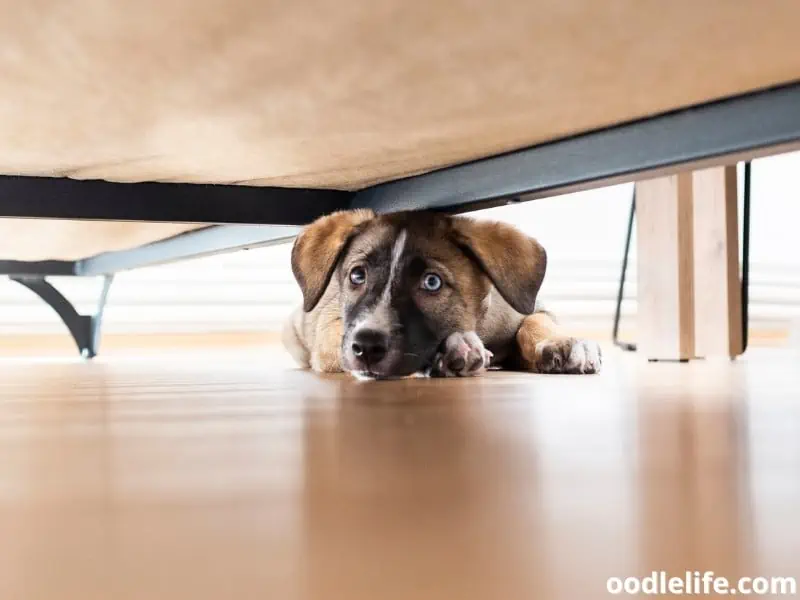
However, green eyes are among the rarest eye colors in dogs.
The blue color caused by heterochromia appears much different than the blue color that dogs may have in their eyes. Instead, a heterochromia blue might be more ghost-like and pale.
How Can Canine Heterochromia Present?
Heterochromia can present in a few different ways. Your dog may have a whole differently colored eye. However, some dogs may only have part of their eye discolored.
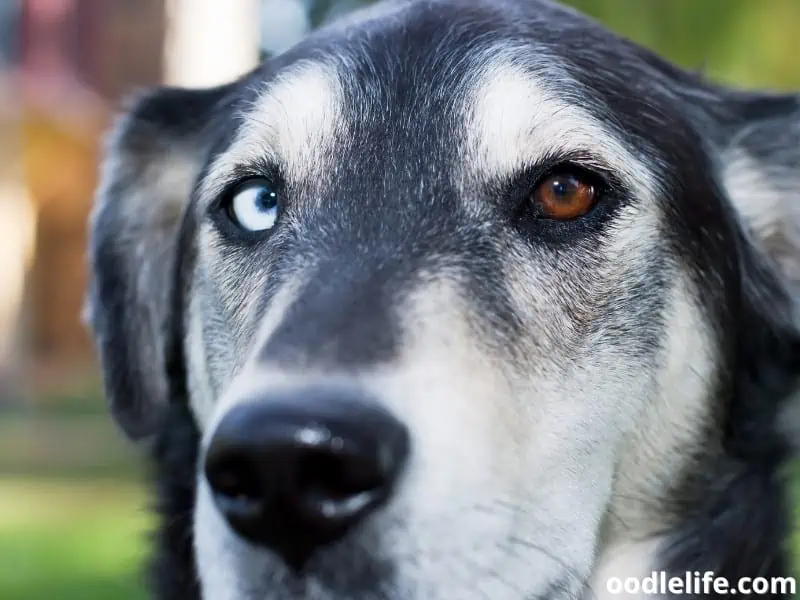
Heterochromia won’t impact your dog’s vision in any way, although it can be a concern for many dog owners.
Be sure to check your dog’s eyes often to ensure no other health conditions are going on with your dog. For example, cloudy eyes can be mistaken for heterochromia but should be followed closely by your local veterinarian.
There Are Three Types of Heterochromia
Heterochromia can come in three varieties. The only impact each type will have on your dog is how they appear. There are no health impacts related to heterochromia.
The types of heterochromia include the following:
- Complete heterochromia
- Central heterochromia
- Sectoral heterochromia
Complete heterochromia means your dog will have two completely different colored eyes. Central heterochromia means your dog has two colors in one eye, but the colors are rings. One ring will be one color, and the outer ring will be a different color.
Sectoral heterochromia is when your dog has a section of one eye that is a different color than the other eye.
What Causes Heterochromia In Dogs?
Heterochromia in dogs is likely a genetic mutation and simply means there is a lack of melanin in a part of one eye. This can be passed down through genetics, meaning one dog with heterochromia can have many puppies with the same condition. However, this genetic mutation can be recessive and may come out of nowhere in a new litter.
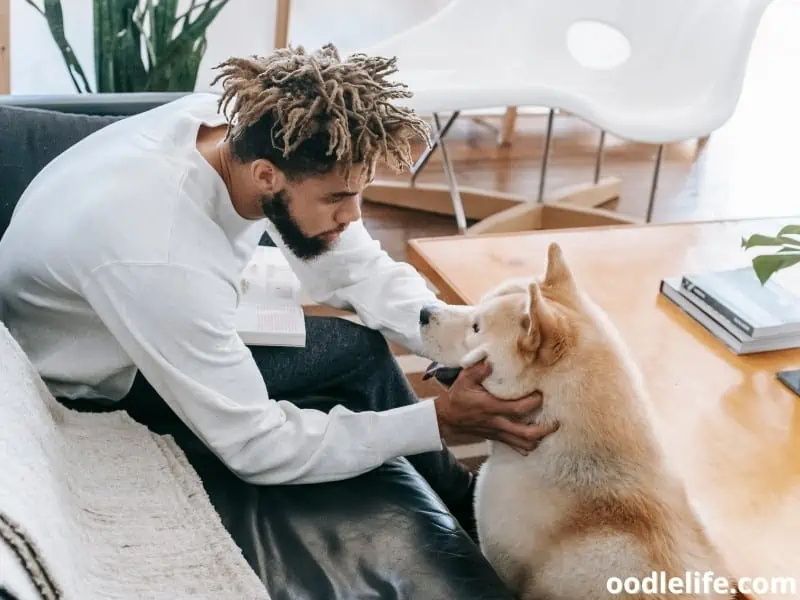
In rare cases, heterochromia can be caused by trauma, including an accident or injury. Trauma-induced heterochromia is rare, and injury is not likely to be the cause of a dog’s heterochromia.
What Breeds Experience Heterochromia The Most?
Heterochromia is more common in some dog breeds than others. These dogs are the most likely breeds you’ll meet with two different colored eyes.
Siberian Husky
Siberian Huskies are among the most beautiful dog breeds. These dogs are the epitome of cold-climate dogs and adore rolling outside in the snow. Siberian Huskies are loyal and outgoing, but these dogs are happy to get mischievous if they aren’t attended to enough.
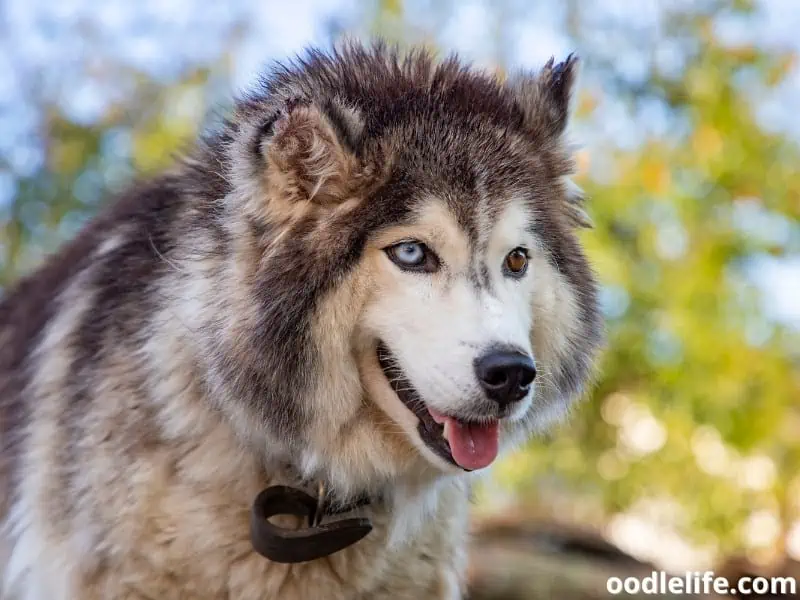
Anyone who has seen a Siberian Husky with heterochromia will tell you how stunning this dog breed looks with two different eyes.
Dalmatian
Dalmatians are among the top breeds to present with heterochromia and can appear regal and elegant with this discoloration. The bluish, white hue will stand out effortlessly against their coat of black and white.

These dogs usually have a pair of brown eyes, but in some cases can have green eyes that match well with heterochromia-induced blue. Dalmatians will need extra care from a veterinarian since this is the only breed afflicted with deafness and other ailments related to heterochromia.
Border Collie
Border Collies are like balls of energy, and it may feel like they’re never pausing, leaving owners feeling exhausted by the end of the day. These dogs are always moving, running, or playing, so it can be hard to note heterochromia on a Border Collie.

However, Border Collies are one of the most common dogs to have heterochromia. These dogs typically have black hair around the head and eyes, making a bluish-white hue in the eyes stand out and make them look royal.
Australian Shepherd
Australian Shepherds are another high-energy dog breed that loves to have some work to do and enjoy herding other living beings, including livestock, children, or their owners.

These dogs may have heterochromia and commonly have green or blue eyes, too. Australian Shepherds can famously have a wide range of eye colors that make them one of the most desired dog breeds for owners looking for heterochromia in their precious pup.
Dachshund
Dachshunds are one of the most common dogs with two different colored eyes. This dog breed usually has a pair of deep chocolate brown eyes that looks stunning against their coat of hair. However, some Dachshunds can have brown, green, or blue eyes, and many of these dogs may have a coat of white or black hair that make these eye colors magnetic.
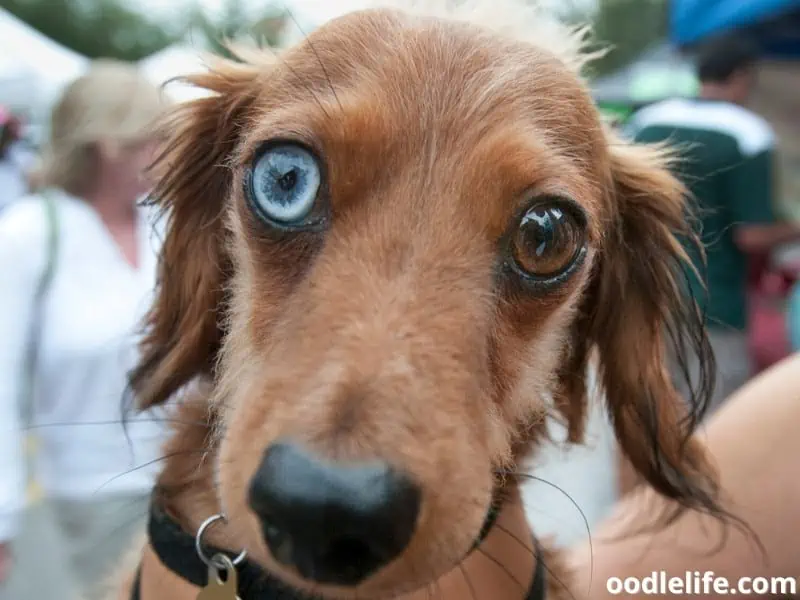
Dachshunds with white hair have heterochromia more than those with dark or black hair.
Shetland Sheepdog
The Shetland Sheepdog is a playful dog who has tons of energy and is willing to solve riddles and puzzles. These dogs are one of the most common breeds to have heterochromia, and anyone who looks at this elegant dog breed might see the resemblance to other heterochromia-prone breeds.
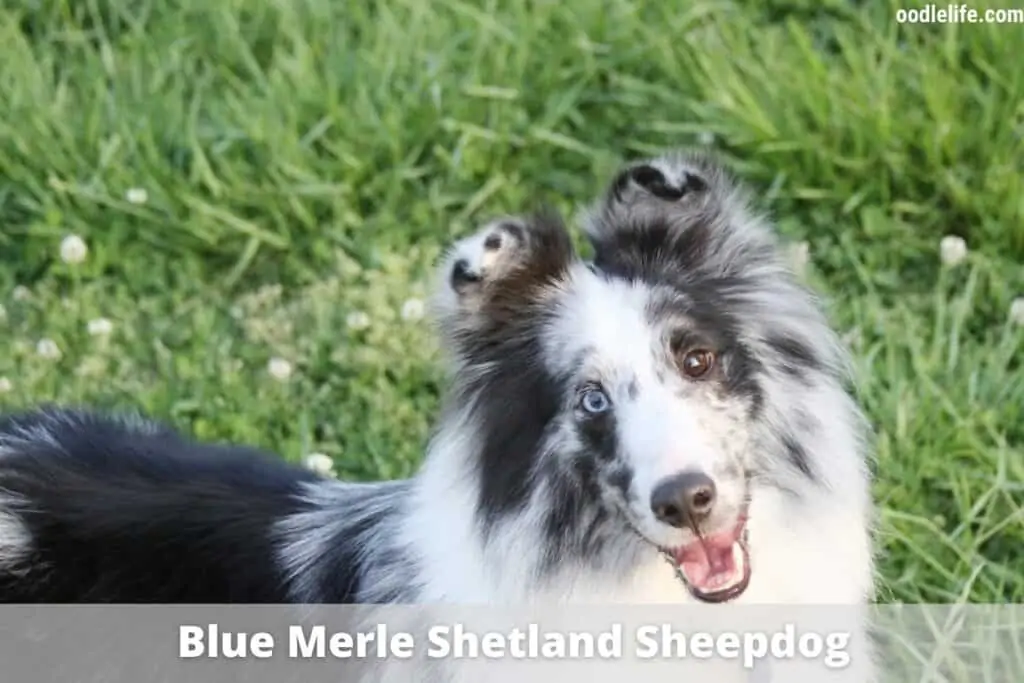
For example, the Shetland Sheepdog looks nearly identical to the Australian Shepherd and the Border Collie, who are also often born with heterochromia.
Frequently Asked Questions
Deciding which dog to adopt or what to do about your dog’s heterochromia can be challenging, but these answers can help you decide how to proceed best.
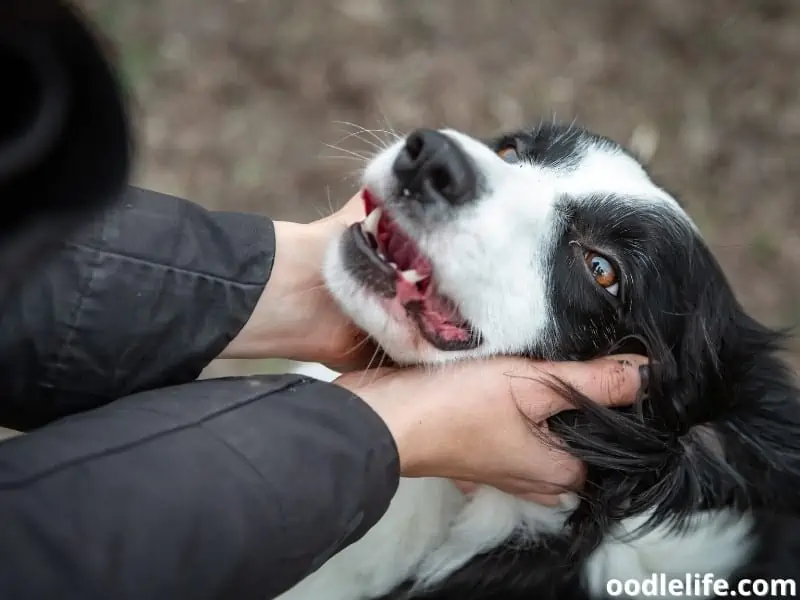
Can heterochromia cause health problems?
Heterochromia won’t cause any other health problems and won’t impact any other aspects of your dog’s life.
Is heterochromia in dogs rare?
Heterochromia in dogs is uncommon but not rare. You are likely to meet a dog with heterochromia while out for a walk in the park.
Will dogs with heterochromia cost more?
Yes, dogs with heterochromia will likely fetch a higher price because of the unique look they present. This increased cost can make a dog with heterochromia several hundred dollars more expensive than one without heterochromia.
Can heterochromia cause blindness in dogs?
Heterochromia doesn’t have an association with blindness in dogs. There are very few cases where a dog may have other ailments directly associated with heterochromia.
Can purebred dogs have heterochromia?
Purebred dogs can have heterochromia. This condition can happen as a result of a genetic mutation and can impact purebreds, designer breeds, and mixed dogs.
Final Thoughts
Heterochromia is an entirely safe condition that won’t likely cause any trouble in your dog and won’t impact its health. This condition can present in a few ways and make your dog look stunning, mysterious, and vibrant. Heterochromia can cause a whole eye or part of the eye to be a different color than your dog’s other eye.
A dog with two different colored eyes can cost more than its siblings because of their elegant and mysterious look. However, the price will depend on the breed, interest from buyers, and other factors. Although this condition is likely a genetic mutation, it’s not a rare condition, and you’ll likely meet a dog with heterochromia at some point.